Dive into the intriguing world of bees and discover the scientific reasons behind their black and yellow stripes.

Why Are Bees Black and Yellow?
Bright, bold, and buzzing, bees are a fascinating spectacle with their distinctive black and yellow stripes. You've probably wondered why these tiny pollinators sport such striking colors. It's not just for aesthetic appeal; there's a scientific basis behind it.
From the basics of bee coloration to the impact of climate on their hues, there's a world of knowledge awaiting you. So, let's embark on this exploration and uncover the mystery behind the bees' black and yellow attire, shall we?
Key Takeaways
- Bee coloration serves important functions in communication and survival.
- Bees have evolved to have trichromatic vision, perceiving colors from ultraviolet to orange.
- The black and yellow pattern of bees serves as a warning to potential predators.
- Bee coloration plays a role in mimicry, with hoverflies imitating the black and yellow pattern of bees.
The Basics of Bee Coloration
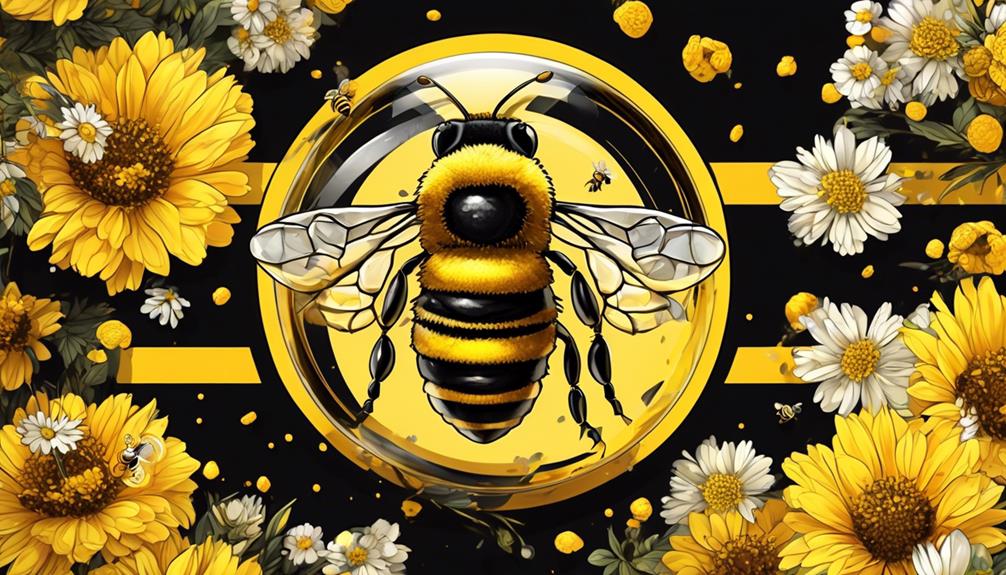
Diving into the basics of bee coloration, you'll find that the classic black and yellow stripes aren't just for show – they serve vital functions in bee communication and survival. These colors aren't random; they're the result of evolutionary adaptations. You see, bees need to be visible to their hive mates, but they also need to deter predators. Their stark coloration does both, balancing the needs of communication and protection.
Let's get analytical. The yellow stripes reflect light strongly in the ultraviolet spectrum, which bees can see. This makes them highly visible to each other, aiding in their social structure. On the flip side, the black stripes absorb UV light, creating a contrasting pattern that's easy for bees to recognize.
But there's another function for the black. It's not just for contrast – it's a warning. Many animals have learned to associate bright yellow and black with danger, a phenomenon known as aposematism. So, by flaunting these colors, bees advertise their ability to sting, deterring potential threats.
In essence, bees' black and yellow stripes are a perfect example of nature's ingenuity, a solution to multiple challenges faced by these industrious insects.
Understanding Bee Vision
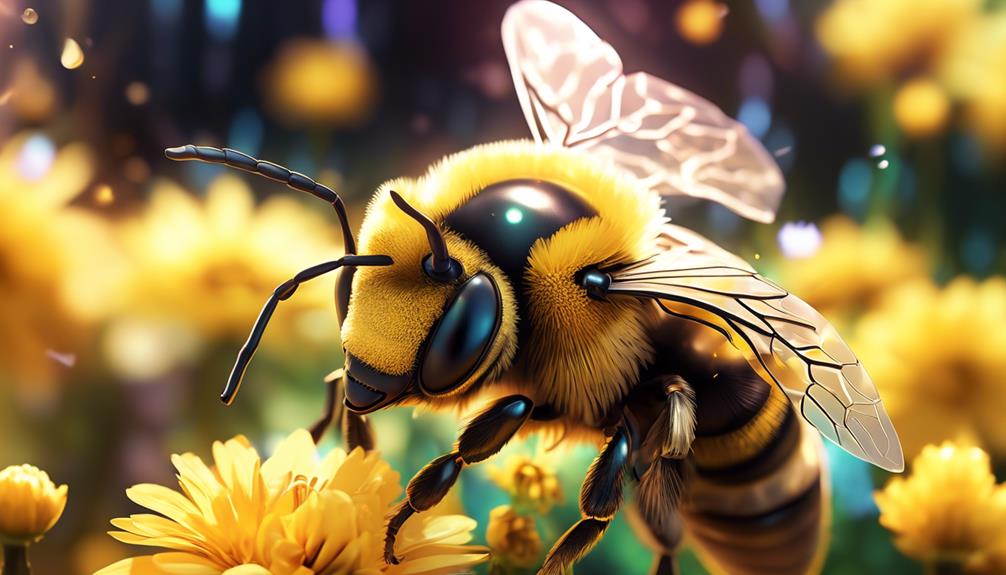
Building on the importance of coloration in bee communication, it's essential to understand how bee vision operates to fully grasp the significance of their black and yellow stripes. Unlike human eyes, bees see the world through a compound eye, comprised of thousands of individual lenses, each capturing a different aspect of the visual field.
Your vision, in the traditional human sense, is trichromatic, meaning you perceive colors as a combination of red, blue, and green light. Bees, however, possess trichromatic vision too, but it's significantly different. Their color perception ranges from ultraviolet to orange, with no ability to discern red hues. This unique visual spectrum allows bees to detect patterns and polarizations in flowers that are invisible to the human eye.
Interestingly, the high contrast between black and yellow is especially noticeable to bees due to their specific color range. This color combination helps bees identify and communicate with each other effectively. Despite their limited color perception, bees have an incredibly sophisticated vision system that has evolved over millions of years to perfectly suit their environmental needs and social behaviors.
Understanding bee vision offers crucial insights into their intriguing black and yellow coloration.
Mimicry and Bee Coloration
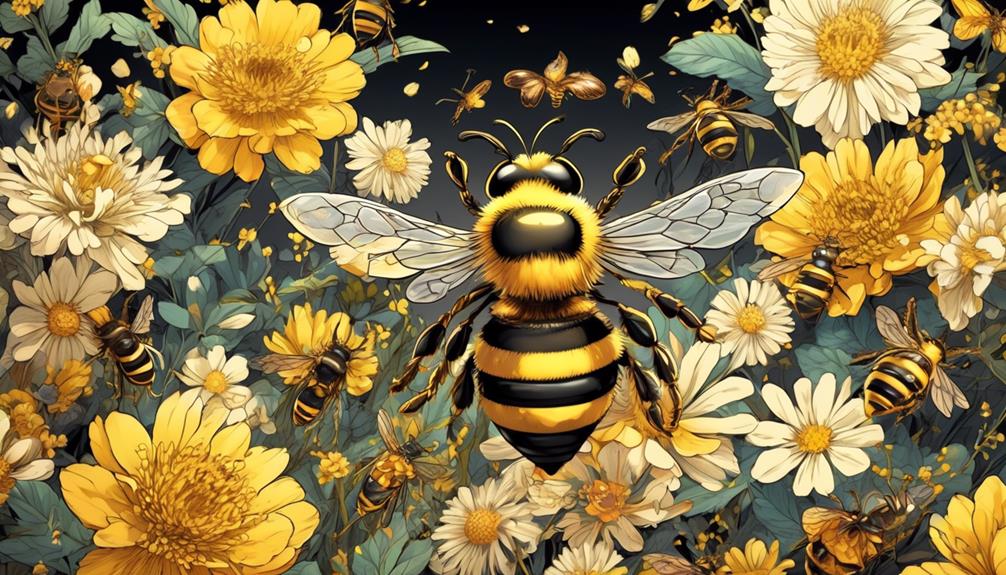
Exploring the world of bees further, you'll find that their striking black and yellow coloration isn't just for communication—it also plays a crucial role in a fascinating biological phenomenon known as mimicry.
In nature, mimicry often serves as a survival strategy. It's a way for an organism to enhance its chances of survival by imitating the appearance of another species. For bees, the black and yellow pattern is a warning. It signals to predators that they're potentially dangerous, and it's best to keep distance.
But bees aren't the only creatures sporting this distinct coloration. You'll also find it in hoverflies, a species that, while harmless, bears a striking resemblance to bees. This is a classic example of Batesian mimicry, where a harmless species imitates the warning signals of a harmful one to avoid predation. It's a clever strategy, isn't it?
In this light, the black and yellow pattern serves not just as a means of communication among bees, but also as a survival tool, a kind of biological deception that helps ensure the continuity of the species. It's a testament to the intricate and fascinating mechanisms at play in the natural world.
The Role of Natural Selection
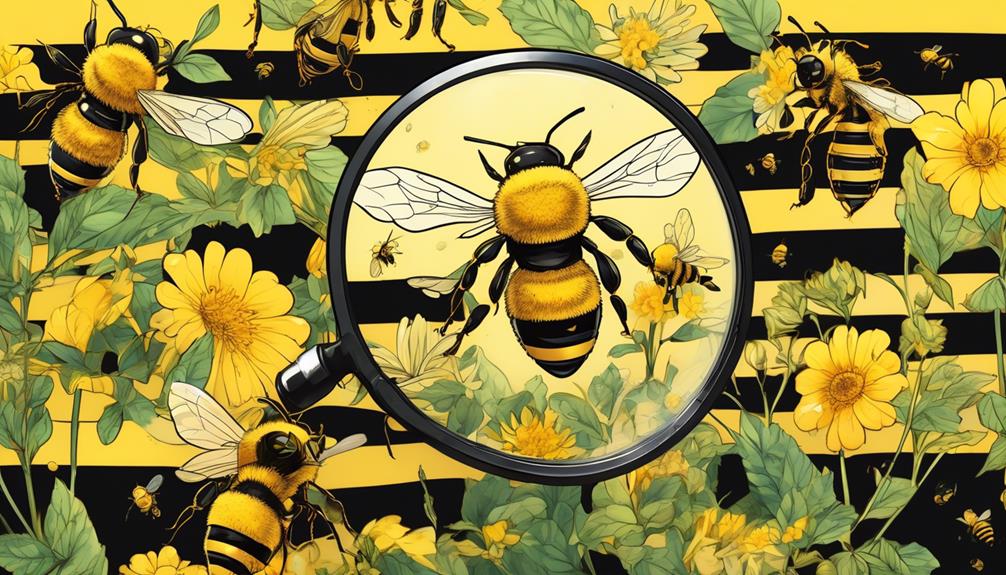
Drawing on the concept of mimicry in bees, you might wonder how this black and yellow pattern emerged in the first place, leading us to the topic of natural selection.
Natural selection is a process through which traits that enhance survival and reproduction become more common over generations. If you consider bees' black-and-yellow coloration, you'll see it's more than just a pretty pattern. It's a survival strategy.
Black absorbs heat, helping bees stay warm, while yellow serves as a warning to predators that bees aren't a safe meal.
Over millions of years, bees that happened to have more black and yellow in their coloration likely survived longer and reproduced more, passing these advantageous traits to their offspring. This is a classic example of natural selection at work.
The environment plays a significant role too. Bees that live in colder climates tend to be darker (more black) to absorb more heat, a clear example of natural selection responding to environmental pressures.
Bee's Black and Yellow Pattern Function
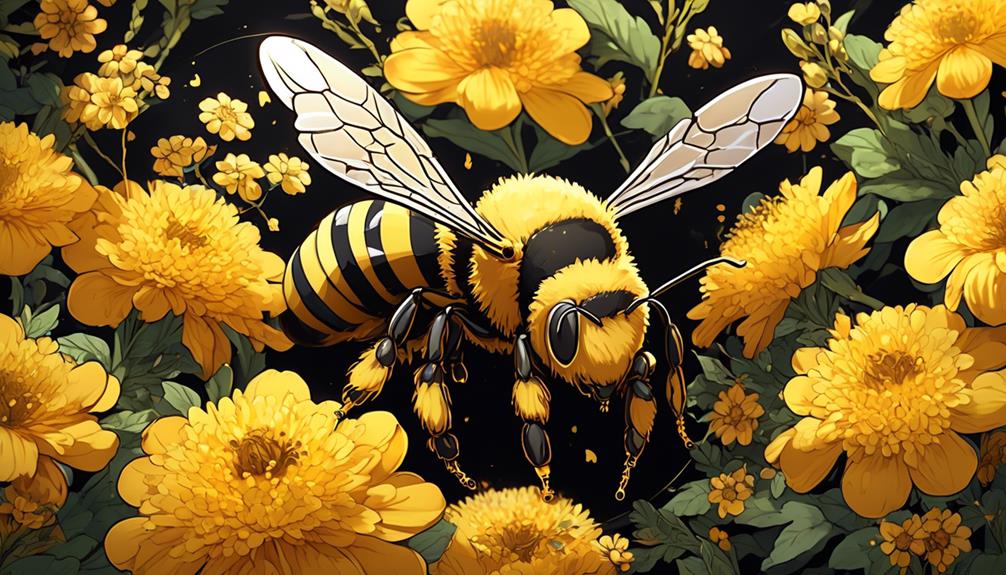
Now, let's delve into the functionality of a bee's black and yellow pattern, a unique adaptation that serves more than just aesthetic purposes. This distinct coloration, known scientifically as aposematism, works as a defensive signal, warning potential predators of the bee's ability to sting. It's a visual stop sign, if you will, designed by nature to prevent unnecessary conflict.
Moreover, the high contrast between black and yellow makes bees more visible and easily recognizable. This visibility is crucial not only for predators but also for flowers. You see, bees are major pollinators, and their black and yellow patterns act like a beacon for flowers seeking pollination. That's essentially nature's version of a business transaction!
But it doesn't stop there. The pattern also functions in temperature regulation. The darker areas absorb heat, helping bees warm up in cooler temperatures. Conversely, the yellow parts reflect light, preventing overheating under the sun.
Impact of Climate on Bee Colors

Delving into the impact of climate on bee colors, you'll find that geographical and environmental factors play significant roles in the variation of these black and yellow patterns. The temperature, altitude and humidity of a region can affect the intensity of a bee's color. For instance, in colder regions, bees tend to have darker and thicker bodies, which is an adaptation to retain heat.
Climate Factor | Bee Color Variation | Reason |
|---|---|---|
Temperature | Darker color | To absorb more heat |
Altitude | Lighter color | Less need for heat absorption |
Humidity | Thicker bodies | To protect from moisture |
The table above summarizes these relationships. Furthermore, you may notice that the colors aren't constant across all species. Some bees, like the Africanized honey bees, are darker than their European counterparts, a trait developed for survival in their respective environments.
Frequently Asked Questions
What Other Colors Can Bees Potentially Have Apart From Black and Yellow?
You might be surprised to learn that bees aren't just black and yellow. They can sport a variety of hues, from metallic blue to green, even red.
For instance, the Blue Carpenter Bee has a striking metallic blue body. Orchid Bees are known for their vibrant green color. Bumblebees in the high Arctic even have an all-black coloration.
How Do Hive Behaviors Influence the Coloration of Bees?
Hive behaviors don't directly influence bee coloration. It's primarily genetics determining their black and yellow stripes. These colors aren't just aesthetic, they're crucial for their survival.
The bold pattern warns potential predators, 'I'm dangerous, stay back!' That's called aposematic coloration.
Are There Any Known Instances of Bees Changing Their Color Over Their Lifetime?
No, there aren't known instances of bees changing their color over their lifetime. Bees' coloration is determined by their genetics at birth and remains constant throughout their lives. They can't change their color like some other animals can.
This is due to the fact that their black and yellow stripes aren't just for show, but serve a vital purpose in their survival, specifically in deterring predators.
How Do Bee Color Patterns Affect Their Interaction With Other Insects or Animals?
Bee color patterns significantly influence their interactions with other animals and insects. You'll notice that their bold black and yellow stripes act as a warning signal to predators, showcasing their ability to sting. This is a survival strategy known as aposematism.
Furthermore, their bright colors attract pollinating partners, aiding in plant reproduction. So, bees' coloration isn't just for show – it's a critical component of their survival and ecological role.
Can Human Activities Like Pollution or Urbanization Impact the Color of Bees?
Yes, your actions like pollution or urbanization can impact bee coloration indirectly.
Pollution, particularly air and water pollution, can affect the plants bees feed on, altering their color.
Urbanization can cause habitat loss, leading to a decrease in the diversity of bee species, including those with bright colors.
However, it's important to note that these changes are gradual and not immediately noticeable.
Conclusion
So, you've uncovered why bees are black and yellow. It's a perfect blend of bee vision, mimicry, natural selection, and climate impact, all working together to create this distinctive coloration.
The black and yellow pattern isn't just for show, it serves a key function for these buzzing creatures. Understanding the science behind the bees' colors gives you a richer appreciation of these vital pollinators and their clever adaptations.



